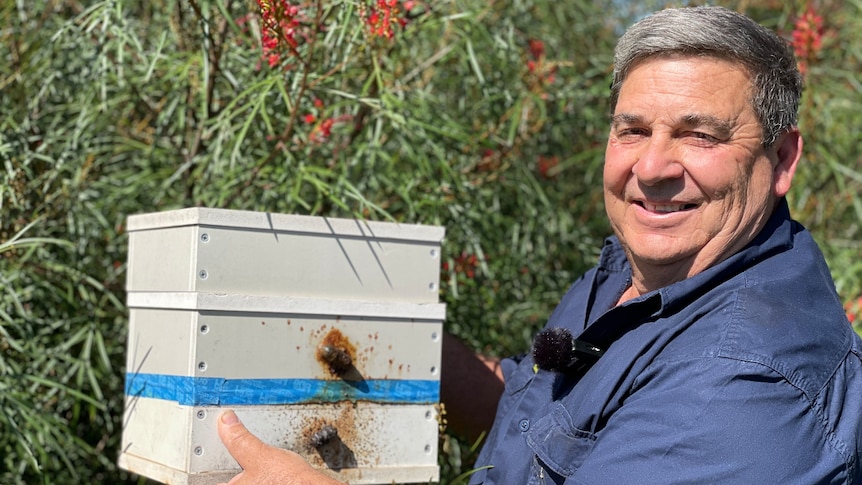“Foster parents” who take care of native beehives in their own backyards have helped a Queensland macadamia nut farmer develop a pollination backup plan should the invasive varroa mite spread.
Key points:
- Geoff Chivers has increased his number of native beehives from five to 150 in the past five years
- “Foster parents” take care of the bees in the off-season when the macadamia trees are not flowering
- The stingless bees are not susceptible to the invasive varroa mite, which threatens honey bees
Geoff Chivers started investigating using the small, stingless insects to pollinate his orchards, which were some of the oldest in Bundaberg, when varroa mite first started spreading around the world.
In five years, he has gone from five beehives to 150, which he said was made possible by a group of enthusiastic locals he called the “foster parents.”
“We need to have feed for those bees in the off-season,” he said.
“We actually host them out to families and friends in Bundaberg who have either large areas of native bush around them or backyards in the middle of town where there’s lots of flowering plants or vegetable patches.”
He was not looking for any new foster parents, with all of the beehives adopted and thriving in their host homes.
“We’ve found that the bees actually flourish in the urban environment because of the variety of flowers and other things that they can collect pollen from,” he said.
Macadamia trees have a short flowering window, and because orchards are large and surrounded by monoculture crops, the bees would not have enough food or variety without their host families.
“The foster parents love it, they really become attached to their hives,” he said.
“While we only need the hives for probably four to six weeks each year, they tell me they actually miss them when they’re gone.
“There’s a lot of people that just love to sit out and watch the bees come and go and just do what they do.”
Win-win for bees and community
All of Mr Chivers’ beehives currently have homes with foster parents like retiree Hugh O’Malley, whose wife Allison first suggested they get involved.
“I’ve got a little vegetable garden and I’d had trouble with a lot of plants, like cucumbers for example, with pollination,” Mr O’Malley said.
“Since we’ve had the bees here, which we have for about three years, things like that are growing quite well.”
He said the bees were low-maintenance and easy to integrate into his existing garden.
“If they need any water they get it off a bit of dew off the grass and of course they know where to go for food,” he said.
“So I don’t have to do anything… I don’t use any sprays or anything like that, which is good for the bees.
“It’s nice to see them there, and they’re no problem because they don’t sting.”
It’s estimated about 90 per cent of the pollination for macadamia nuts is done by honey bees, but with the detection of the devastating varroa mite in New South Wales, farmers in Queensland have been considering their options should bee numbers drop significantly.
Patience pays off
Mr Chivers said it had taken years of experimentation and education to get the native bees working in his orchard, but he was seeing tangible results.
“We placed the bees around the outside of the orchard believing that they would move through the orchard,” he said.
“What we actually saw was around the outside of the orchard, we’re getting a much better nut set, but not so much into the orchard.
“We started experimenting [with] moving the hives actually inside the orchard… we put a grid pattern throughout the orchard so each hive is no more than 50 meters from another hive.”
In one of the oldest orchards in the district, he said kernel recovery — a measure of how much nut is inside the shell that determines what the grower is paid — had risen from 30 to 35 per cent.
Some limits
While it was a success for his farm, Mr Chivers acknowledged there were limits to how much the bees could do in place of traditional honey bee pollination, particularly when it came to breeding and splitting beehives, which is a much slower process in the stingless varieties. .
“We couldn’t go out tomorrow and get enough hives to pollinate all the macadamia orchards or other farms around here, but we have enough now, I believe to pollinate, all our own farms,” he said.
“There are other insects [than bees] that probably do pollinate macadamias. From our own experience, we believe the native bees do a really good job.
“And to be quite frank, even if they don’t contribute a lot to the pollination of the trees, it’s a wonderful hobby to actually have these native bees.”
The native bees were also unlikely to help out in some of the colder climates, such as for almonds in Victoria, as foster parent Hugh O’Malley observed.
“I know these little fellas in my backyard, if we get a really cold day they stay in for the day,” he said.
Vice president of the Queensland Beekeepers Association Brad Jensen said professional honey beekeepers pollinated about $14 billion worth of crops across Australia each year, highlighting how critical the industry was to food production.
“Without the bees they’ll have to look for other crops to grow,” he said.
.
